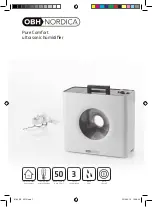
5
www.thermastor.com • [email protected]
Toll-Free 1-800-533-7533
The mixture of gas and liquid refrigerant enter the
accumulator after leaving the evaporator coil. The
accumulator prevents any liquid refrigerant from reaching
the compressor. The compressor evacuates the cool
refrigerant gas from the accumulator and compresses it to
a high pressure and temperature to repeat the process.
4.3 Troubleshooting
No dehumidification, neither blower nor compressor run
and power switch does not light when ON.
. Unit unplugged or no power to outlet.
2. Power switch defective (Sec. 2.6).
3. Loose connection in internal wiring (Fig. 3).
No dehumidification, neither blower nor compressor run
with power switch ON & lit.
. Low pressure control open (Sec. 2.0).
2. Power switch defective (Sec. 2.6).
3. Loose connection in internal wiring (Fig. 3).
Some dehumidification, blower runs continuously but
compressor only runs sporadically.
. Unit is in defrost cycle (Sec. 2.9 & 4.7).
2. Defrost thermostat defective or loose (Sec. 2.9 & 4.7).
3. Loose connection in compressor circuit (see Fig. 3).
4. Defective compressor overload (Sec. 4.6A).
5. Defective compressor (Sec. 4.6).
6. Defective relay (Sec. 4.0).
No dehumidification, blower runs but compressor does not.
. Bad connection in compressor circuit (Fig. 3).
2. Pump safety switch closed
2. Defective compressor capacitor (Sec. 4.6A).
3. Defective compressor overload (Sec. 4.6A).
4. Defective compressor (Sec. 4.6).
5. Defective relay (Sec. 4.0).
Blower does not run. Compressor runs briefly but cycles on
& off.
. Loose connection in blower circuit (see Fig. 3).
2. Obstruction prevents impeller rotation.
3. Defective blower (Sec. 4.5).
Unit removes some water but not as much as expected.
. Air temperature and/or humidity have dropped.
2. Humidity meter and/or thermometer used are out of
calibration.
3. Unit has entered defrost cycle (Sec. 2.9 & 4.7).
4. Air filter dirty (Sec. 3.).
5. Defrost timer incorrectly set for conditions (Sec. 2.9 &
4.7).
6. Defective defrost thermostat (Sec. 4.7)
7. Low refrigerant charge (Sec. 4.4).
8. Air leak such as loose front cover.
9. Defective compressor (Sec. 4.6).
0. Restrictive exhaust ducting (Sec. 2.5)
Unit runs but does not pump water.
. Hose kinked or plugged.
2. Pump motor or float switch defective (Sec. 4.8).
3. Pump check valve plugged (Sec. 4.8).
4. Bad connection in pump circuit (Fig. 3).
5. Hose disconnected internally.
Unit pumps water automatically but not when purge switch
is pushed.
. Bad connection in purge switch circuit (Fig. 3).
2. Defective purge switch (Sec. 2.7).
Evaporator coil frosted continuously, low dehumidifying
capacity.
. Defrost thermostat loose or defective (Sec. 2.9 & 4.7).
2. Defrost timer incorrectly set or defective (Sec. 2.9 &
4.7).
2. Low refrigerant charge (Sec. 4.4).
3. Dirty air filter or air flow restricted. (Sec. 3.).
Compressor runs with power switch OFF.
. Defective relay (Sec. 4.0).
2. Defective power switch (Sec. 2.6)
4.4 Refrigerant Charging
If the refrigerant charge is lost due to service or a leak, a
new charge must be accurately weighed in. If any of the
old charge is left in the system, it must be removed before
weighing in the new charge. Refer to the unit nameplate for
the correct charge weight and refrigerant type.
4.5 Blower Replacement
The centrifugal blower has a PSC motor and internal
thermal overload protection. If defective, the complete
assembly must be replaced.
. Unplug the power cord.
2. Remove the top panel and cabinet front (6 screws).
3. Disconnect the blower leads.
4. Remove the four screws holding the blower outlet
flange to the cabinet end.





























